Art & Exhibitions
Artist Michelle Stuart on Why Her Half-Century’s Worth of Interventions Into the Earth Are More Relevant Than Ever
At 89, Michelle Stuart reflects on art, nature, and translating the landscape into art.
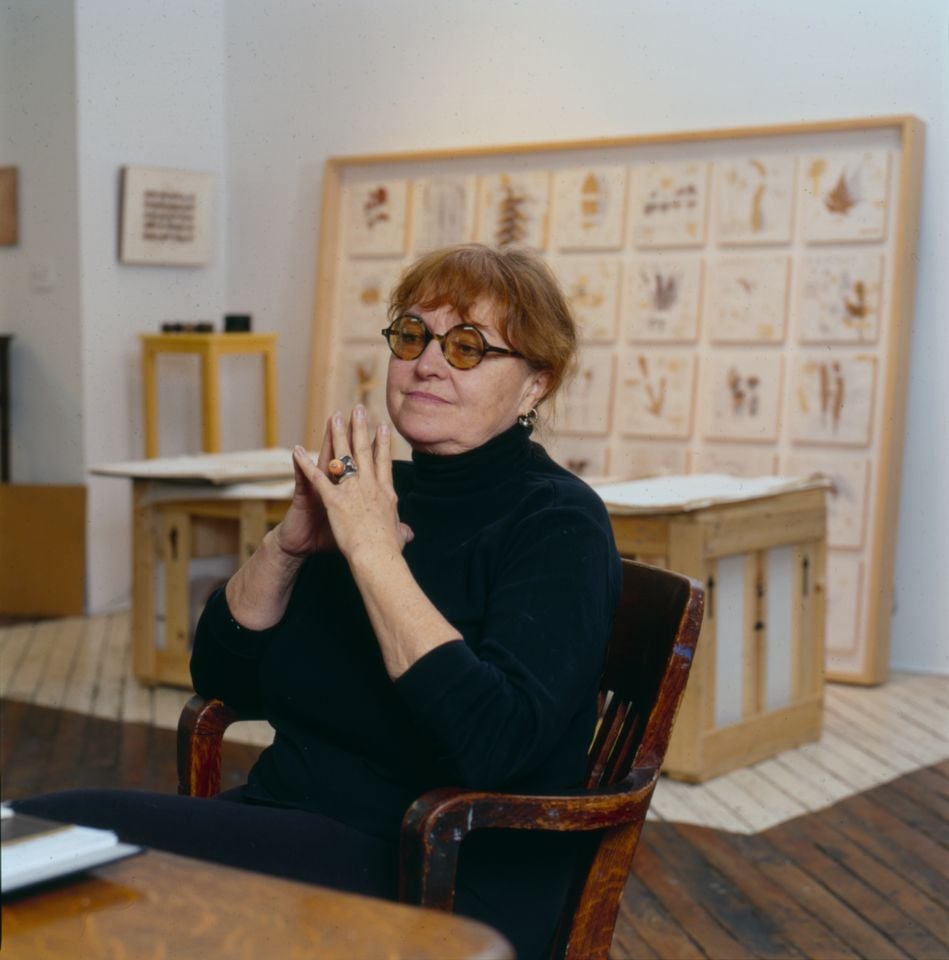
At 89, Michelle Stuart reflects on art, nature, and translating the landscape into art.

Sarah Cascone

If you enter Michelle Stuart’s current New York solo show, “The Imprints of Time, 1969–2021,” expecting to see Land Art, you might feel confused. There is no documentation of large-scale sculptural interventions changing the face of the landscape—but make no mistake, many of these works involve the physical transformation of the earth.
For many years, the Los Angeles-born artist collected physical remnants of the earth during her travels around the world, bringing it back to the studio and painstakingly grinding piles of dirt and rocks onto thick sheets of paper to imbue it with natural earth tones. It’s a process that “reduces mountains to grains of sand,” art critic Lucy Lippard once wrote.
Now 89, Stuart has spent decades creating art that engages with natural environment, carefully archiving materials and breaking down eons of embodied time into orderly grids. Her literally groundbreaking career is set to be the subject of an upcoming documentary film, Michelle Stuart: Voyager, from director Karen Bellone and producer Karen S. Shapiro.
Ahead of the final days of her show at Galerie Lelong, Artnet News spoke to Stuart about drawing inspiration from nature, working with the earth, and her lifelong determination to make art.
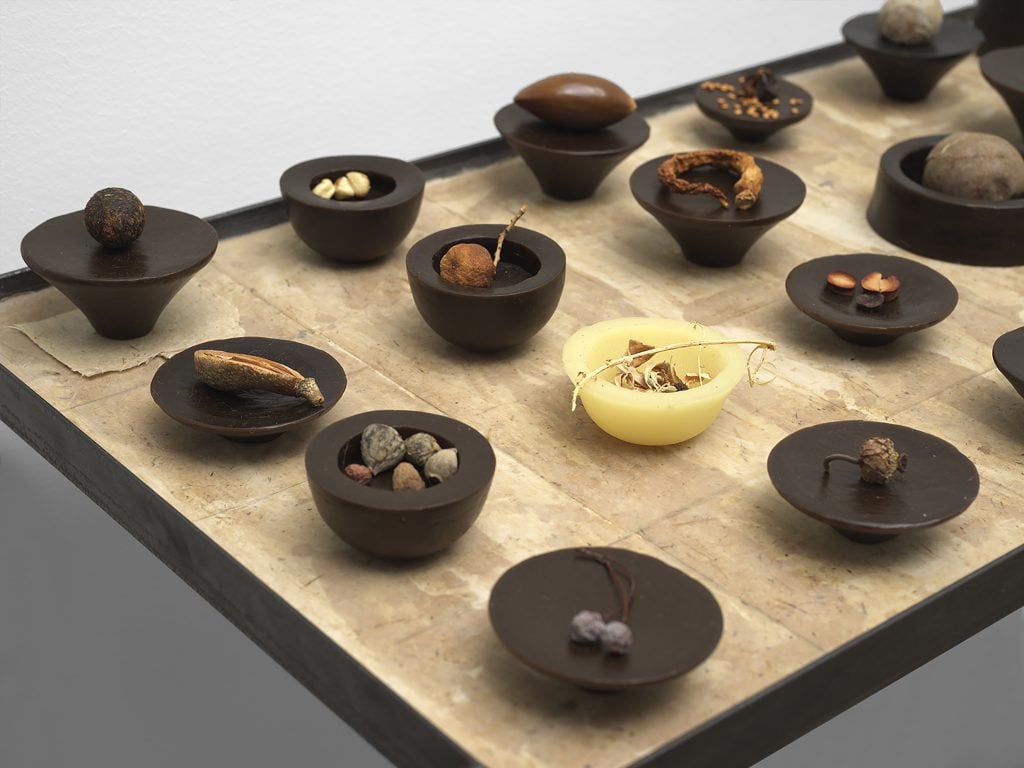
Michelle Stuart, Collection Table (for Rumpf) 1997. Photo courtesy of Galerie Lelong and Co., New York.
To help understand your work, with its unusual approach to material and subject matter, it might help to go back to the beginning. What was your art education at Los Angeles’s Chouinard Art Institute, today part of CalArts, like?
It was terrible. I only went there briefly, because I didn’t like it that much. It was a boys’ schools, really. Some of the teachers were fine with women, but some weren’t. One of them said to me, “I don’t know why women bother to go to art school. There aren’t any women artists anyway. They must know that.” Of course, I was already determined, but I never forgot it. Can you imagine an art teacher saying that?
The one experience at Chouinard that was a positive one was that Bernard Leach, an English ceramist, and Shoji Hamada, a Japanese potter, came for a talk. I was in a clay class, so I went, and it was really a revelatory exploration.
Hamada just sat on the ground with a pot and a wheel, and showed us how he made pots. He didn’t speak English, so Leach of course translated for him, about how in Japan and Korea it was alright if there was a mistake in art, because only God was perfect. I thought it was a beautiful sentiment, not in any religious sense, but in the sense of espousing chance as a gift to the artist. It encapsulated the idea of time. It was a really memorable experience for me.
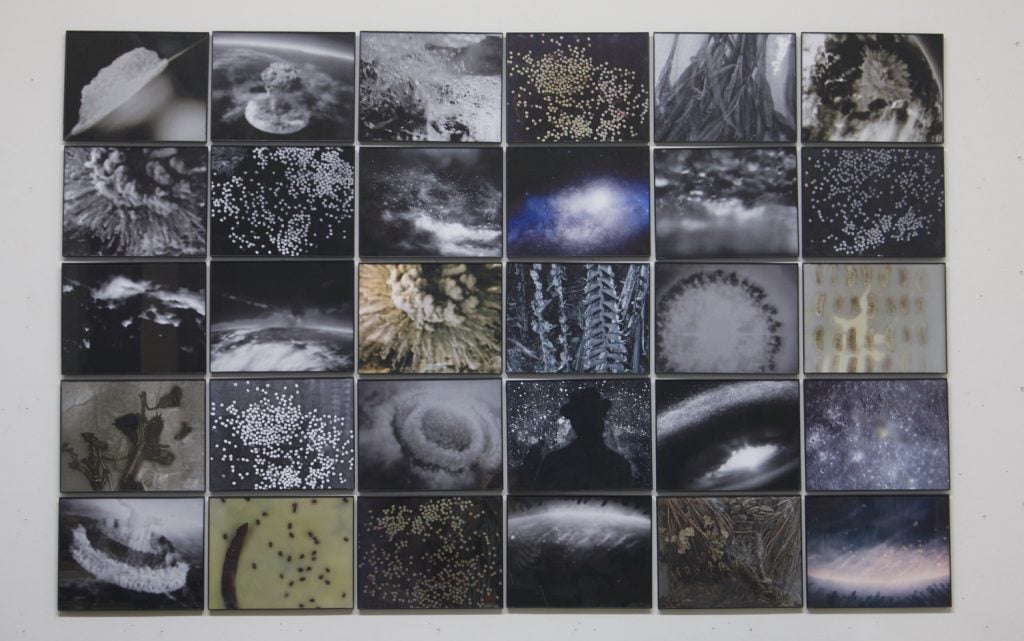
Michelle Stuart, Creation Myth (2020). Photo ©Michelle Stuart, courtesy Galerie Lelong and Co., New York.
You mentioned that you were already determined to be an artist when you got to art school. When did you first know that was your life goal?
Very early. I was very fortunate in having parents who appreciated art. My father loved words and books and my mother loved art. When I started making art as a child, my mother would put it on the walls and say “this is really good.”
In high school, I took a class at night with a Hungarian draftsman, Francis de Erdely, at Jepson Art Institute. My mother drove me since I was too young to drive. He had classes in drawing that were very traditional, with corpulent models. It was classical, in-the-round depth drawing. He would take the pencil from you and do his idea for what the arm or the leg should be right over your drawing. It was very European. But I learned how to draw with him. Really, I learned how to see.
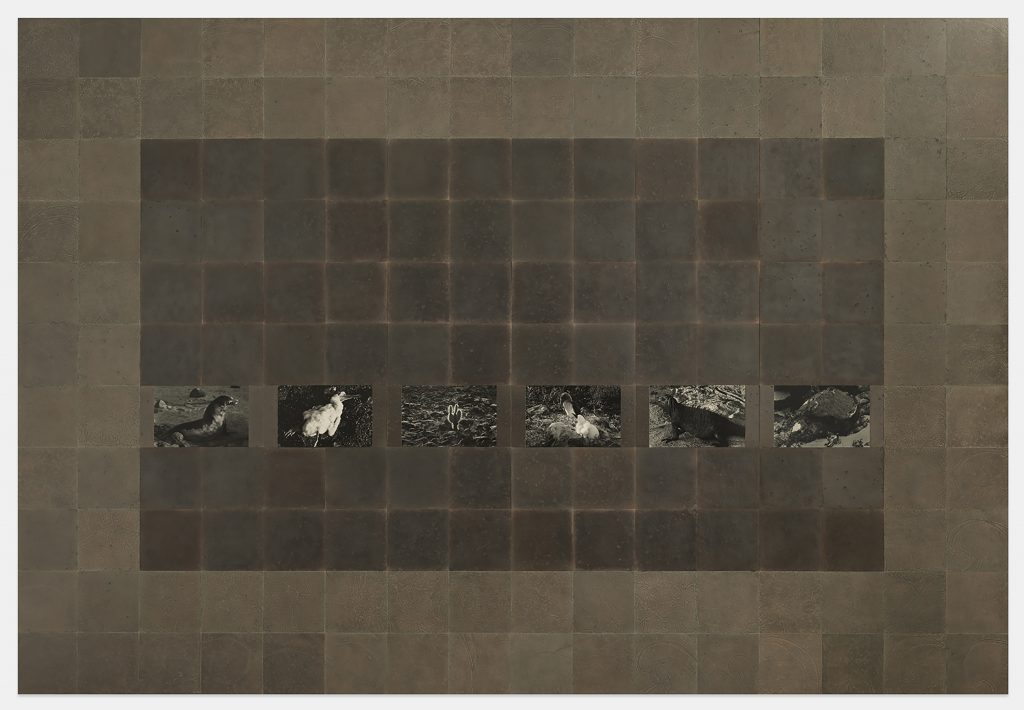
Michelle Stuart, Islas Encantas: Seymour Island Cycle (1981–82). Photo courtesy of Galerie Lelong and Co., New York.
It seems to me like your father’s work in mapping the landscape in preparation for installing water lines across California might have been an influence in the direction that your work ultimately took.
Well, yes and no. I was too young when he was doing that to really be influenced by that, but we traveled around California a lot. My father liked to show my mother and I the landscape, the desert, and the sea. And he gave me the gift of loving books. It takes a lot of different things to become an artist. Reading books and reading poetry, that’s part of the building structure of what you later feel when you see something.
How did you come to work as topographical draftsperson for the United States Army Corps of Engineers?
That happened because I needed a job. I got a job with an engineering and architectural firm as a draftsperson. I was good at it, and they were hired by the Army Corps of Engineers to map Korea, because the Korean War had started.
At that time, maps were translated from aerial photographs. But we had big aerial photos that were all over the wall, and we would make drawings with all the roads and where the buildings were situated. Once we inked them in India ink, then they were photographed. But I never saw the end product!
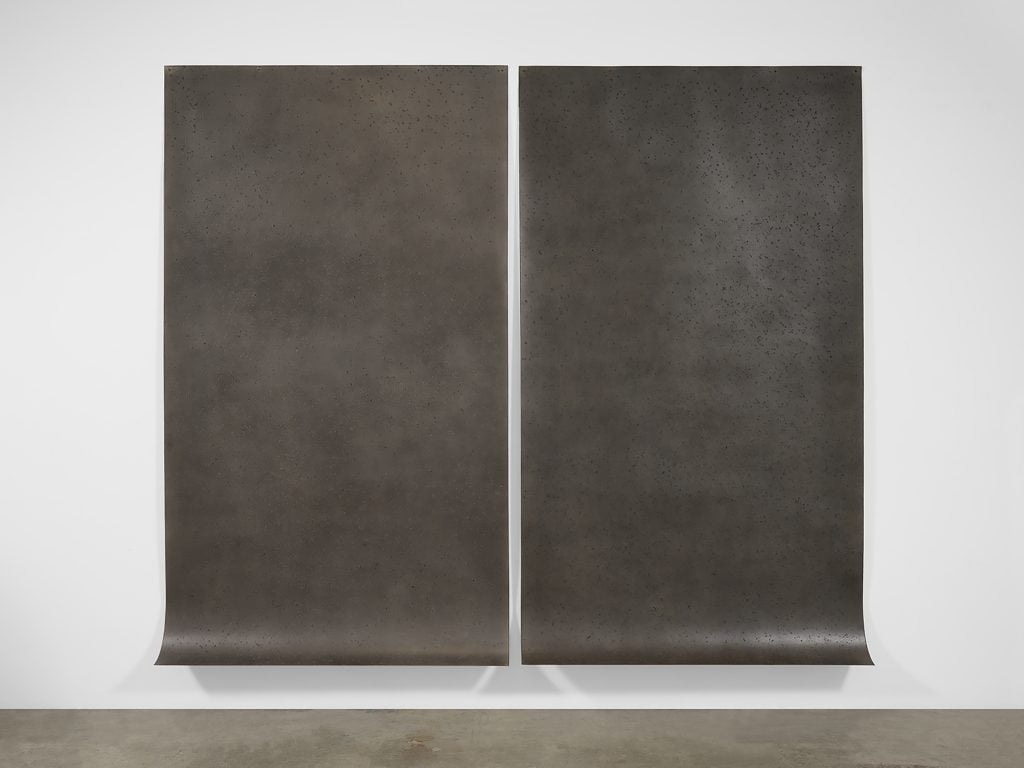
Michelle Stuart, El Florido (1978-79). Photo ©Michelle Stuart, courtesy Galerie Lelong and Co., New York.
Do you see any parallel between that work mapping the landscape and your work as an artist, literally translating the landscape onto paper you can hang on the wall?
I never thought about it actually. Everything you do influences your art. In a very obscure way, I ended up translating the surface of the earth. It’s a huge jump, but it’s not an impossible jump. But this is the first time I’ve ever explained what I did when I was drafting to anyone.
Well that’s my job as an art writer, to try and make connections, however obscure they might seem. But I’m curious then, what did give you the idea to use dirt, graphite, and other elements of the landscape for mark-making?
I can’t really say that one thing gave me the idea. Previously, I had been working in sculpture, and I started doing boxes of earth. I wanted to capture the earth. And at the same time, I was doing drawings of the surface of the moon. And then I took that and started thinking about the surface of the earth.
I used this heavier paper that I was actually familiar with from drafting. It’s muslin-backed, indefatigable paper. They don’t make it anymore, but it was it was made for mapmaking. I laid it on the surface of the earth and I started rubbing. I loved the way that it gave me itself. It embraced me as much as I embraced it. There was a kind of dialogue between the earth and me. That’s the only way I can put it.
After a couple of years, I went to McDowell Colony, where you could get away from New York City for a couple of months. They gave me a barn. I took all my paper up to this barn and I started putting the earth on top of the paper and smashing it in and rubbing it. It was not just the reflection of the rubbing of the earth. It was the indention of the earth, and the color of the earth.
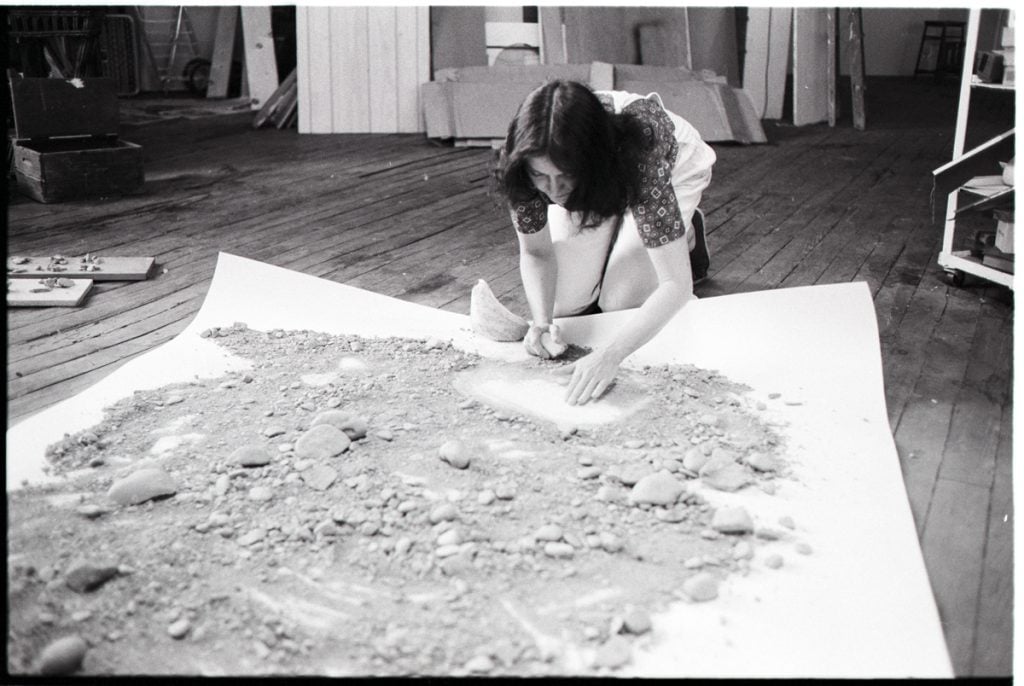
Michelle Stuart working on one of her scrolls. Photo by Lorie Sebastian, courtesy of the artist.
Do you relate that work to the history of women’s labor and women’s work?
Are you reading Lucy [Lippard] now? [Laughs.] She does. I don’t, but that’s okay. I love Lucy. That’s her perception.
And is it true that the process would actually cause your hands to physically bleed?
That has, happened yes. Lucy said “masochistically”—but I certainly didn’t want that to happen. Some earth has so many hard edges, little pieces of quartz and things. I tried not to have that happen, but sometimes it did.
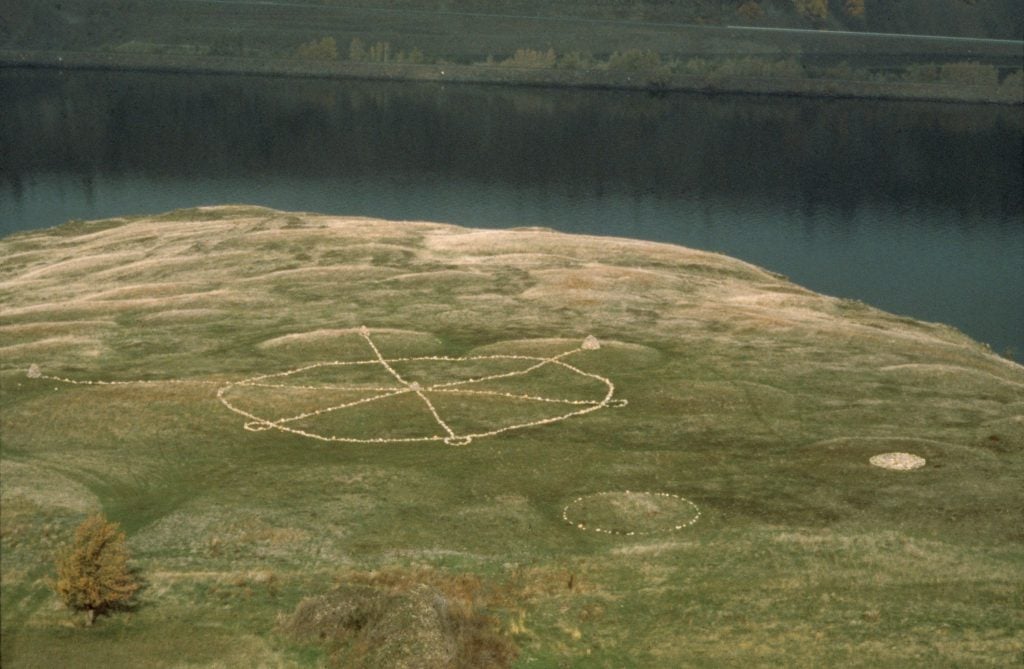
Michelle Stuart, Stone Alignments/Solstice Cairns (1978-79). Photo ©Michelle Stuart, courtesy Galerie Lelong and Co., New York.
What was your relationship to the Land Art movement when it was first becoming part of the art discourse? Was it something you consciously considered yourself to be part of?
I wasn’t actively thinking about it, but of course you can’t escape knowing a little bit about different concepts that are going on.
I was invited to Oregon to do a solstice piece in 1978 [at the now-defunct Portland Center for the Visual Arts]. And I said, “Can I do a Land Art piece?” And they said yes, but they only had a pittance amount of money for the show. So I had to pay to fly back and forth, but they got me an assistant, and they found a man who wanted to get rid of his rocks. He had horses, and they were always falling over them.
We went to see this gentleman. He gave us this pickup truck and said “take all the rocks that you want.” It was the best exercise in the world. Picking up all these rocks, taking them to the site, and building it was a great adventure. We camped out there.
We had to figure out where the north south axis would be, and where the sun was going to come up and where it would set. And it worked beautifully. [The final piece, titled Stone Alignments/Solstice Cairns, is Stuart’s sole surviving earth work.]
The difference [from the larger Land Art movement] was that most of my works were of the moment. I didn’t do things that I wanted to last forever. People were building monumental earthworks and they bought they land so they would be there as long as possible. That was not in my mind. For me, these were transitory works, for those who wanted to go and participate in them.
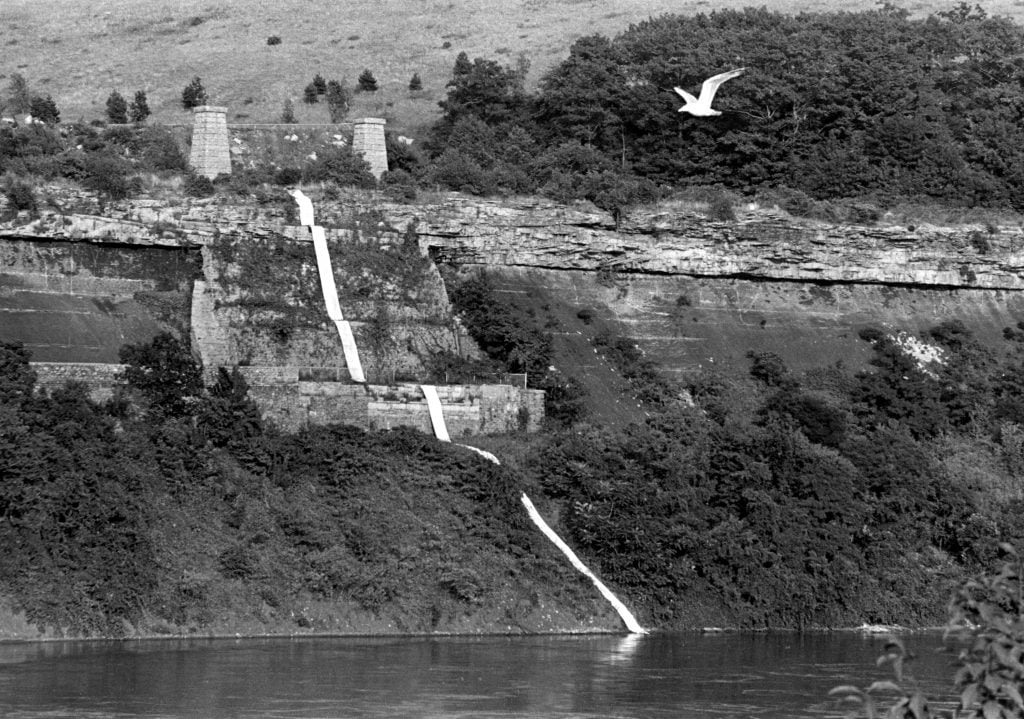
Michelle Stuart, Niagara Gorge Path Relocated (1975). Photo by George MacDonald, ©Michelle Stuart, courtesy Galerie Lelong and Co., New York.
That was certainly the case with Niagara Gorge Path Relocated, one of your best-known earthworks, which you created in 1975 at Artpark in Lewiston, New York.
It was the first large piece that I did. It lasted about a month. It was all about time, land and time. I researched the area and found it had been the original site of Niagara Falls 12,000 years ago. So I reiterated the falls with one of my scrolls, but it was 460 feet long. The paper came in 30-foot increments and I had to sew all the segments together by hand.
But I have to admit, I had helpers. It’s the only time that I’ve ever done [rubbings] that I ever shared the experience. I was doing the piece up on top of the plateau, and these young people would come by and they said, “oh, what are you doing? Oh, we love that!” So I said “here, join the club!”
Putting the piece down was kind of hair-raising. But it was a lovely endeavor, and all the other artists in Artpark helped out—all of them guys, of course.
And the site there, it was an escarpment where you could see all the different layers of stratification in the earth. You’ve also done work with quarries. What appeals to you about the way that the landscape reveals layers of history just by looking at it?
The landscape shows you things you never pay attention to. They’re all taken for granted. A 1,000 years can be a little strain of strata that goes through the earth. When you have a gorge or there’s been a big dig in a quarry, it opens up the world as it appeared before us, millions of years.
When I was a child, my father used to take me to Rancho La Brea, which is now La Brea Tar Pits. LACMA was not there. It was all tar pits where animals of the Pleistocene Age had gone to get water and been caught in the tar. There were extinct animals and plants, and it was revelatory to me as a child. They have a museum now with a big elephant, but when I was a child, they only had a concrete sculpture of a saber tooth tiger.
The incredible beauty of the stratification of the earth gives us is insight into our past. Different time produced different colors and different minerals. It’s a song of the past, really, when you think about it. Most people do not look at the landscape that way. But the real landscape is time. It’s a timescape.
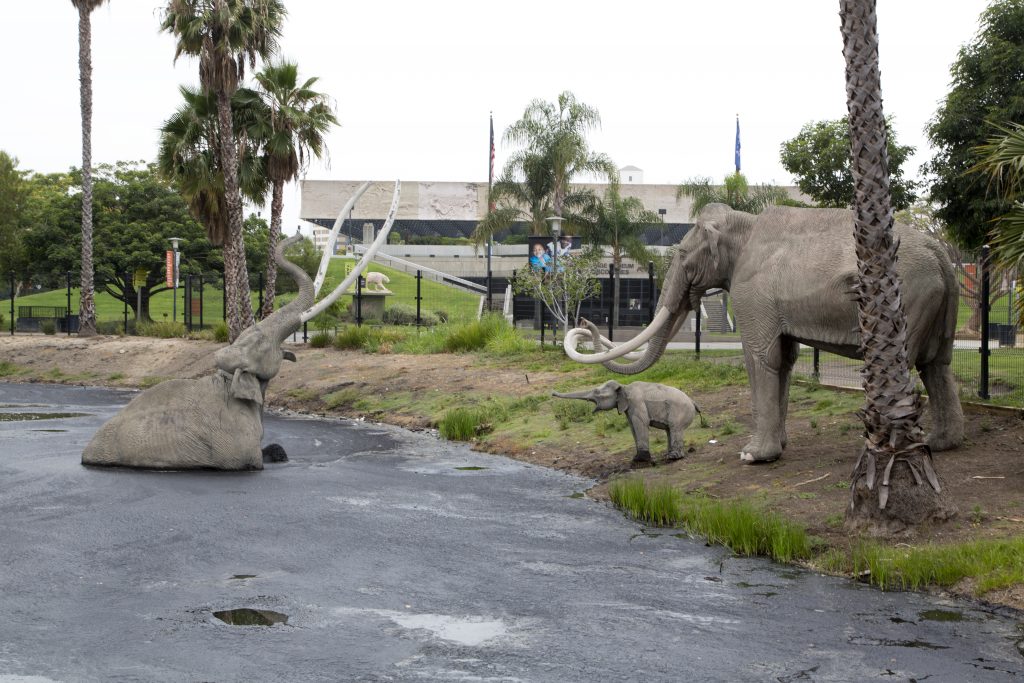
La Brea Tar Pits, Los Angeles, California. Photo by Carol M. Highsmith/Buyenlarge/Getty Images.
One of the pieces in the show, Extinct, has all these plant specimens that you collected. I wonder when you’re looking at this history of the earth, are you looking ahead to the future with the fear of the consequences of human activity?
Of course, I’m very interested in that. It’s hard to delineate those ideas. Just as its hard for artists to do political proselytizing without being incredibly boring, it’s hard to make art and say what you profoundly feel about what we’re doing to our planet. You have to do a kind of a dance between the poetry of life and the kind of disaster we’re heading for.
It’s very hard to be subtle about something like extinction. I try to be, because I want it to be art, but it’s hard to make it art and make it strong so that people feel it. It’s hard to make it say something, and still have it be art.
But those were not really extinct plants—there was a rose in there. It was a metaphor. It was taking plants that we love and saying, “there’s a possibility these will no longer exist.” But that was 1990 or ’91 when I made that work, and now it’s true. Now we’re really at the abyss.
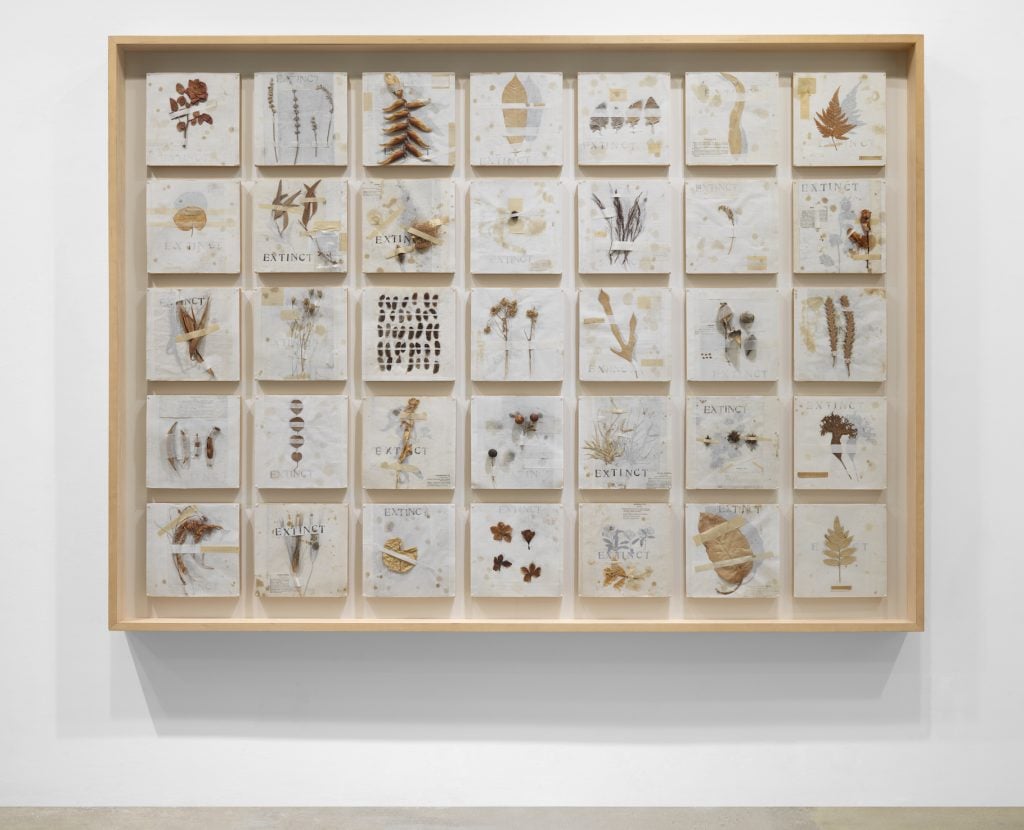
Michelle Stuart, Extinct (1992). Photo ©Michelle Stuart, courtesy Galerie Lelong and Co., New York.
On a different note, that piece is also a great an example of the way that you kind of use an organizing grid, creating almost like an inventory that feels very scientific in its approach. Where does that come from?
I always liked science. I was very interested in it when I was in school. I half considered archaeology as a profession, but I was better at art and I was terrible at math. I always liked the structure of things. The grid gives me a beautiful structure. It’s there to hang chaos on. You can use to talk about time, because the breaking up of space is calendrical.
My seed drawings started as a calendar thing. I thought of their growth period. A seed is so positive. Embedded within it is everything it is, and it grows to repeat itself, so it lives forever. It’s kind of immutable.
I remember reading about an archeological dig in China where they found all those clay soldiers. The archaeologists on that dig unearthed a boat, and there had been some lotus seeds in the boat. They said to themselves, “I wonder if these seeds still are viable.” And in fact, they were. They were thousands years old, but a couple of them sprouted. And I thought, this is the most beautiful, positive thought. We can destroy everything. And yet buried somewhere, there is going to be the life force.
So I started doing those calendars, which I think are kind of positive views of our badness.

Michelle Stuart, Seed Calendar: One Month Five Days in Bali, Java and Sulewesi 1994). Photo courtesy of Galerie Lelong and Co., New York.
I want to note that you’ve collected these seeds and other natural materials from your travels around the world. What are some of the challenges of working this way?
Sometimes it’s impossible! I went to Hawaii, and they wouldn’t let me take anything. California doesn’t like it either. New York doesn’t give a shit. You can bring almost anything into New York. This city is not agricultural. I’ve brought stuff in from South America, from all over, but I don’t take it from anyplace where I would damage anything, and I don’t bring back any bugs. You have to be careful about that.
And how do you pack? Is your carry-on suitcase just full of dirt?
I just put it in boxes. And I’ve been known to hide it!
“Michelle Stuart: The Imprints of Time, 1969–2021” is on view at Galerie Lelong, 528 West 26th Street, New York, February 24–March 26, 2022.